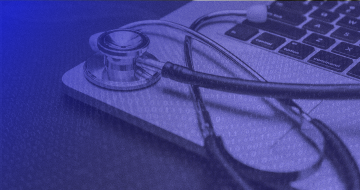Healthcare workers are under constant pressure to keep up with the latest technologies. As new devices and systems are introduced into the healthcare industry, maintaining security and protecting patient data becomes increasingly difficult. In order to stay ahead of the curve and deliver high-quality care, healthcare workers need to be aware of the top five healthcare information security trends for 2022.
Identity as a Password
It's time to utilize your biometric data as identification credentials. Biometric authentication is highly effective for securing data and other sensitive information because of the uniqueness of biometric characteristics.
Healthcare systems have made significant investments for clinicians to log into enterprise systems more efficiently. Employee badge access has proven to be quite effective, but it’s time to explore using Face ID in the enterprise. Simple biometric system access would be a significant satisfier for hospitals, as they constantly strive to implement solutions that prevent staff burnout.
One area of caution is that biometric identity can't be "reset," like a password. A biometric identity breach may create a considerable burden that is more intrusive than a password breach.
Code Check Vigilance
We're living in an API era, where systems are increasingly moving data between on-premises and cloud systems at a breakneck pace. However, threat actors are still finding holes in API security. The desire to build digital services and link them with other apps opens up a vast attack surface for malicious threat actors to exploit.
In this world, APIs offer attackers an easy path for infiltration. Health system developers must check their development code vehemently with an emphasis on security during the development cycle.
Healthcare Must Stop Building Security Infrastructure In-House
CIOs and CISOs must shift their focus of building an in-house security team and transition to a managed security service offering. We are currently facing a technology talent shortage, and the deficit is more significant in information security. Increases in remote work, use of mobile devices, and cloud services have been notable, and they have facilitated a substantial change in the way businesses need to function where healthcare in-house security teams cannot keep up anymore.
A security operation is more than just a department, team, or set of technologies. It's a group of well-executed procedures carried out by people whose mission is to keep the company safe. To rapidly identify and combat threats and minimize risk, security operations specialists need current security solutions and training.
The recommendation is to hire a managed security service firm to provide that service with a 24x7 security operations center, network detection, response, and other features that may be added to the technology team. When you can't compete with the professionals, health systems must cease building such costly teams in-house.
Contingency Planning Must Include Infosec
Whether internal or external, an information security event will affect every healthcare organization. The recent UKG Kronos outage is affecting the ability of the health system to handle payroll, and many people are being forced to use a manual procedure. Sophisticated organizations that had contingency plans were able to operate in a semi-automated way.
Preparation is the key. Organizations have business continuity plans to deal with natural disasters, pandemic outbreaks, or large-scale failure of a critical system. This plan must include a cyber scenario with tabletop exercises simulating cyberattacks to increase readiness for future incidents.
Beef Up Your Security Awareness Training
With the same urgency as handwashing, hospital and health system executives must drive home the need for information security. The current obliged security training is only there to fulfill a requirement vs. ensuring that employees have the skills they require in today's climate.
Create frequent security training exercises by embedding the organization's DNA into everyone's DNA, which states that safeguarding digital assets is everybody's responsibility and not just the CIO or CISO's. The content has to be engaging and relevant for clinicians. It’s time to revamp the security awareness training requirement in hospitals.
The five healthcare IT security trends for 2022 are a wake-up call for health systems. These trends should prompt a behavior change and increased vigilance when it comes to protecting patient data. Healthcare organizations need to be proactive about safeguarding their systems and devices while preparing for the potential consequences of a data breach.
By staying ahead of the curve and preparing for these security threats, health systems can continue delivering high-quality care while ensuring the safety of their patients’ data.
You Might Also Like
Secureworks has been acquired by Sophos. To view all new blogs, including those on threat intelligence from the Counter Threat Unit, visit: https://news.sophos.com/en-us/.

